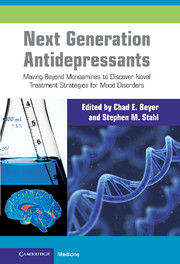 Next Generation Antidepressants
Next Generation Antidepressants Published online by Cambridge University Press: 19 October 2021
Prevalence of depression has increased progressively over the last decades. Besides the impact on human quality of life, the pharmaco-economical impact of this syndrome requires ongoing development of newer, more powerful antidepressants. While optimizing existing therapeutic compounds, multiple approaches can be taken to generate superiority over these compounds. The delay in onset of action of antidepressants is of relevance as the presence of side effects during the initial absence of clinical effects causes low therapy compliance. Obviously, a decrease in onset of action would overcome this problem. Current therapy still induces considerable side effects depending on the class of antidepressants used. Reducing these has multiple advantages, such as it will increase compliance but also facilitate the rapid and safe initiation of drug treatment. In line with safety requirements is the notion that new antidepressants should not be prone to hazardous effects in overdose, nor should they induce dangerous interactions by interfering with other treatment. Finally, it is currently recognized that depression is a cluster of symptoms rather than a concise disease. To this end, it is recognized that more tailored treatments might be required in the future. Arguably targeting subsymptoms and comorbid features such as anxiety are of high relevance. Attempts to improve antidepressants have been made into monoamine-related strategies, but also more recently in non-monoamine strategies. The effectiveness of monoamine-targeted selective, dual- and triple-uptake inhibitors and augmented uptake inhibitors is discussed. In addition, new strategies such as monoamine non-uptake inhibitor drugs or non-monoamine drugs exerting effects on Glu, gamma-aminobutyric acid (GABA), Substance P, and acetylcholine are discussed, as are more miscellaneous approaches.
To save this book to your Kindle, first ensure [email protected] is added to your Approved Personal Document E-mail List under your Personal Document Settings on the Manage Your Content and Devices page of your Amazon account. Then enter the ‘name’ part of your Kindle email address below. Find out more about saving to your Kindle.
Note you can select to save to either the @free.kindle.com or @kindle.com variations. ‘@free.kindle.com’ emails are free but can only be saved to your device when it is connected to wi-fi. ‘@kindle.com’ emails can be delivered even when you are not connected to wi-fi, but note that service fees apply.
Find out more about the Kindle Personal Document Service.
To save content items to your account, please confirm that you agree to abide by our usage policies. If this is the first time you use this feature, you will be asked to authorise Cambridge Core to connect with your account. Find out more about saving content to Dropbox.
To save content items to your account, please confirm that you agree to abide by our usage policies. If this is the first time you use this feature, you will be asked to authorise Cambridge Core to connect with your account. Find out more about saving content to Google Drive.